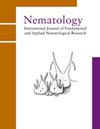Ficogaus religiosus的分子表征和重新描述(Bajaj&Tomar,2014)Davies&Bartholomaeus,2015来自印度的Ficus religiosa
IF 1.1
4区 生物学
Q2 ZOOLOGY
引用次数: 0
摘要
在新德里(印度)生长的神圣无花果树(Ficus religiosa)中发现了大量的无花果。根据形态学、形态计量学特征和分子数据,我们将该种群重新定义为Ficophagus religiosus。在这里,通过对雄性和雌性标本分类特征的测量和显微照片,对主要的形态学特征进行了深入的描述。宗教性食道可以很容易地通过螺旋到J螺旋形的身体、唇盘不偏移、SE孔靠近唇区的基部、探针长度男性为17.7(16-19)μm,女性为19(15-22)μm、长度为8.3μm(5-10μm)的短子宫后囊、具有宽而高的髁突的针状物、小头扁平或凹陷、,穗状尖端(钝圆形或尖头),没有葫芦,没有引带,三对(P3,P3a,P4)尾下乳头,和宽或钝圆形的尾尖,没有短尖头。此外,还提供了28S rDNA(LSU)和18S rNA(SSU)标记基因的D2-D3区的新序列数据。利用最大似然和贝叶斯方法推断印度宗教F.religiosus种群与其他食Ficophagus物种的系统发育关系。基于D2-D3和SSU分子标记的系统发育分析结果表明,宗教F.religiosus与其他Ficophagus物种明显分离。本研究重新描述了宗教F.religiosus物种,并为识别和建立与其他物种的系统发育关系提供了分子数据。本文章由计算机程序翻译,如有差异,请以英文原文为准。
Molecular characterisation and redescription of Ficophagus religiosus (Bajaj & Tomar, 2014) Davies & Bartholomaeus, 2015 from Ficus religiosa in India
A population of Ficophagus was discovered in the syconia of sacred fig (Ficus religiosa) grown in New Delhi (India). Based on morphology, morphometric characters and molecular data, we redescribed the population as Ficophagus religiosus. Here, major morphological characteristics are described in depth, with measurements of the male-female specimens’ taxonomic characters and photomicrography. Ficophagus religiosus can be easily identified by the spiral to J-spiral-shaped body, labial disc not offset, SE pore close to the base of the lip region, stylet length 17.7 (16-19) μm in males, and 19 (15-22) μm in females, a short post-uterine sac of length 8.3 μm (5-10 μm), a spicule with broad and high condylus, capitulum flat or depressed, a small bluntly rounded rostrum, the spicule tip (bluntly rounded or pointed), no cucullus, no gubernaculum, three pairs (P3, P3a, P4) of subventral caudal papillae, and broadly or bluntly rounded tail tip, without mucron. Additionally, new sequence data for the D2-D3 region of 28S rDNA (LSU) and 18S rDNA (SSU) marker genes are provided. Maximum likelihood and Bayesian methods were used to infer phylogenetic relationships of the Indian population of F. religiosus with other Ficophagus species. Phylogenetic analyses based on D2-D3 and SSU molecular markers resulted in a clear separation of F. religiosus from other Ficophagus species. The present study redescribes the species F. religiosus and provides molecular data to identify and establish phylogenetic relationships with other species.
求助全文
通过发布文献求助,成功后即可免费获取论文全文。
去求助
来源期刊

Nematology
生物-动物学
CiteScore
2.60
自引率
33.30%
发文量
67
审稿时长
3 months
期刊介绍:
Nematology is an international journal for the publication of all aspects of nematological research (with the exception of vertebrate parasitology), from molecular biology to field studies. Papers on nematode parasites of arthropods, and on soil free-living nematodes, and on interactions of these and other organisms, are particularly welcome. Research on fresh water and marine nematodes is also considered when the observations are of more general interest.
Nematology publishes full research papers, short communications, Forum articles (which permit an author to express a view on current or fundamental subjects), perspectives on nematology, and reviews of books and other media.
 求助内容:
求助内容: 应助结果提醒方式:
应助结果提醒方式:


